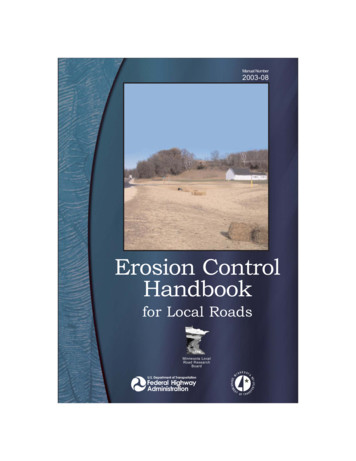Basic Soil Erosion And Types - University Of Wisconsin .
Basic Soil Erosion and Types2015 Wisconsin Lakes ConventionStacy DehneDATCP Engineer
Types of Soil Erosion Raindrop or splash erosion: Erosion preceded by the destruction of the crumb structure due to the impactof falling raindrop on the surface of soil is termed as splash erosion. Sheet erosion: It is the fairly uniform removal of soil in thin layers from the land surface, oftenscarcely perceptible, especially when caused by wind. Areas where loose, shallowtopsoil overlies compact soil are most susceptible to sheet erosion. Rill erosion: A form of water erosion in which numerous very small and more or less straightchannels are produced; the channels get obliterated by ordinary use. It can beremoved by normal tillage operations. Gully erosion: A form of water erosion in which gullies are produced by combination ofunattended rills. Stream bank erosion: Stream banks are eroded by water either flowing over the sides of a stream orscouring at the base. It is aggravated by removal of vegetation, over grazing orcultivation near the stream banks.
Slope angle and length affects runoff generated whenrain falls to the surface. Examine the diagram belowshowing the relationship between hill slope position,runoff, and erosion.Figure 11.10 Hill slope position, runoff & erosion
Soil TypesAbility to resist erosion forces
Soil Has Different Properties From:Geologic OriginCompositionChemical and PhysicalErosion based on:Cohesive (clay) vs. Non cohesive (sand)Density and Particle SizePermeability and Change due to COMPACTIONStrength – Tensile, Shear, Bearing CapacityWater Table and SaturationVegetation and Roots
Geologic Origin Parent Material character and chemical composition of the parent materialplays an important role in determining soil properties Glaciers, Floods, and Water MovementAs glaciers pushed, they act like giant bulldozers pushing soilahead of them. Glacial ‘till’ or ‘drift’ deposits resulted many tensor even hundreds of miles from where the soils were first formed. Water is also very important in moving soils. As rivers flow, theytransport soil particles along. If soil is washed into a river, thesmallest particles will be carried the furthest by the water as theyweigh the least. Heavier particles, such as sand, will be droppedearlier. Soils dropped around streams are termed ‘alluvial’. Soilsdeposited in lakes are called 'lacustrine', soils deposited by rivers'riverine' and by sea 'marine' alluvial soils
CompositionPercent Silt, Clay, Sand, GravelUniform or Poorly GradedLayered Horizontally or DiagonallyDensely Packed or LooseParticle Sizes
Chemical and Physical PropertiespH, Conductivity, Calcium Carbonate and plant survivalSoil StructureSusceptibility of soil to sheet and rill erosion by waterPlasticity IndexWater Content
Vegetation Holds SoilTurfGrass4.0 Ft16 Ft
ErosionDepends on Soil PropertiesHighly Erodible Lands (Parent Material)Cohesive Clays or Non-cohesive sandsDensely Packed or Loose MaterialsPermeability and Water Movement (seeps)How Soils perform under loading (structures)Effective stress and water table fluctuations
Various Techniques or Combinations ofTechniques to “Help” Soils Prevent ErosionNatural Shoreline Native Plantings Biolog w/ Plantings Branch BoxBreakwater Brush Mattress Live Fascine Branch Packing Vegetated Geogrid Rock Riprap Rock Riprap w/ LiveStakes; “vegetatedriprap” Demo/Experimental
Biolog3 YEAR OLD BIOLOG
TechniquesBrush Mattress
TechniquesLive Fascine
Branchbox Breakwater
TechniquesBranch Packing
TechniquesVegetated Geogrid
Vegetated Riprap
Case Studies (1)Problem ID & Techniques used
Case Studies (1)Problem ID & Techniques Used, cont
Case Studies (1)Design Standards & Lessons Learned
Case Studies (2)Problem ID & Techniques Used
Case Studies (2)Design Standards & Lessons Learned
Case Studies (3)Problem ID & Techniques Used
Case Studies (3)Design Standards & Lessons Learned
Upland RunoffErosion Factor
ShoreMax Product
Questions?
Types of Soil Erosion Rain drop or splash erosion: Erosion preceded by the destruction of the crumb structure due to the impact of falling raindrop on the surface of soil is termed as splash erosion. Sheet erosion: It is the fairly uniform removal of soil in thin layers from the land surface, of
Erosion is the detachment and movement of soil particles by wind, water, and gravity. Natural erosion (geologic erosion) is a process that occurs slowly over millions of years. Geologic erosion has shaped the landscape around us. Accelerated erosion is NOT
Soil erosion is the detachment of soil particles and loss of surficial soil by the actions of water, ice, gravity, or wind. Water -generated erosion causes the most severe damage to a site under development. Sedimentation is the consequence of erosion when the eroded soil particles are deposited in
Erosion Control Handbook for Local Roads 7 1.2 Physical and Environmental Factors Affecting Erosion Erosion can be caused by wind, gravity, or water. However, water-generated erosion is the most damaging factor, especially in developing areas. The five types of water erosion and tech
Weathering, Erosion, and Deposition in the Texas Ecoregions: Weathering, erosion, and deposition shape the topography and soil characteristics of Earth's surface. For example, in Texas, these processes have formed a variety of landforms (beaches, plateaus, mountains, and canyons) as well as soil types (fertile soil, clay rich soil,
WATERSHED MANAGEMENT ORDINANCE TECHNICAL GUIDANCE MANUAL 5/26/2020 4.1 GENERAL SOIL EROSION AND SEDIMENT CONTROL REQUIREMENTS PAGE 4-2 4.1 GENERAL SOIL EROSION AND SEDIMENT ONTROL REQUIREMENTS §400.1 of the WMO requires erosion and sediment control practices for all projects, rega
NDDOT Erosion & Sediment Control - Construction Course Wind Erosion and Deposition 29 Erosion Facts (USDA NRCS Soil Quality - Urban Technical Note No. 1 "Erosion and Sedimentation on Construction Sites") Construction sites can erode at a rate of 100 to 500 tons/acre/year 100 times greater than cropland 2,000 times greater than woodlands 30
3 Objectives of Soil Mechanics To perform the Engineering soil surveys. To develop rational soil sampling devices and soil sampling methods. To develop suitable soil testing devices and soil testing methods. To collect and classify soils and their physical properties on the basis of fundamental knowledge of soil mechanics. To investigate the physical properties of soil and
ASP/ASP.NET IIS platform is slowly losing popularity. At the same time, it is still not as robust and mature as we would hope. PHP is so popular because a lot of PHP sites are WordPress sites. WordPress sites are often unsafe but rather static. After you select the theme and plugins, you don’t change much. The attack surface changes only when you update WordPress, themes, and plugins. And .























